The Somme - 2016
The Somme is a department of France, located in the north of the country and named after the Somme River.
The Battle of the Somme, also known as the Somme Offensive, was a battle of the First World War fought by the armies of the British Empire
and French Third Republic against the German Empire.
It took place between 1 July and 18 November 1916 on both sides of the upper reaches of the River Somme in France.
The battle was intended to hasten a victory for the Allies.
More than three million men fought in the battle and one million men were wounded or killed, making it one of the deadliest battles in human history.
We left Paris on a high-speed train to Arras in northern France.
The 180km, very smooth and comfortable trip, took 50 minutes.

Arras
Arras is a city of about 130,000 people in northern France about 180km from Paris.
Established during the Iron Age by the Gauls, it was once part of the Spanish Netherlands,
a portion of the Low Countries controlled by Spain from 1556 to 1714.
The city of Arras is well known for its architecture, culture and history.
We spent 4 nights in Arras, while we did daily tours to the World War 1 battlefields.
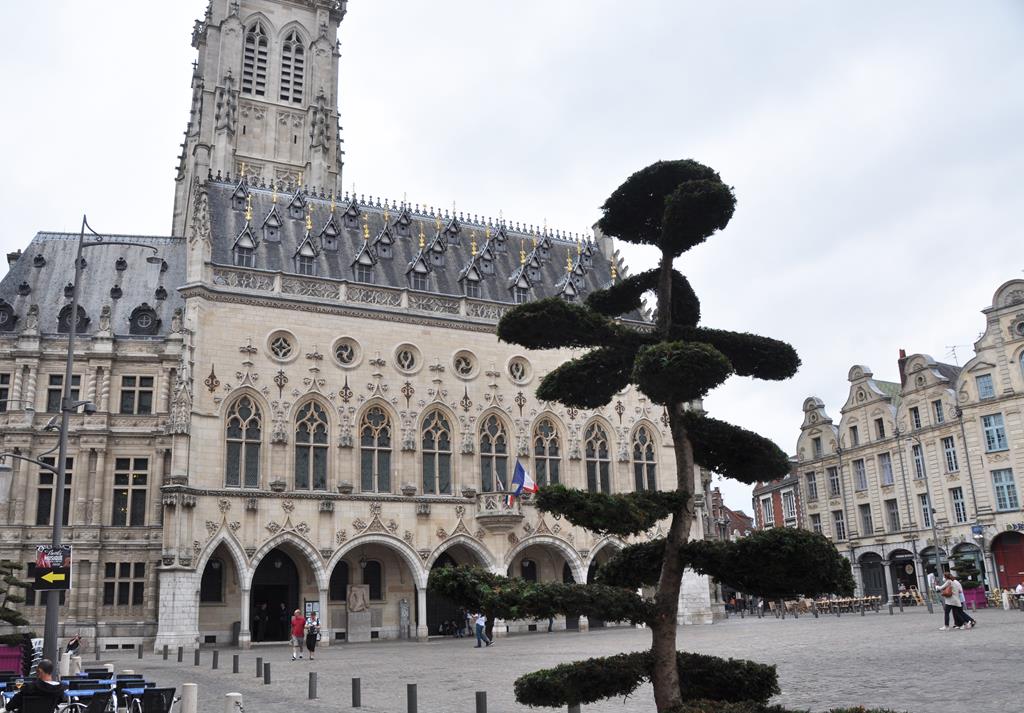
Our first stop, not far out of Arras, was at a place where farmers leave unexploded shells that they uncover in their fields.

The Windmill Site near Pozières
"The Windmill site ... marks a ridge more densely sown with Australian sacrifice than any other place on Earth".
Over seven weeks in 1916, at the Battle of the Somme, the Australian Imperial Force suffered 23,000 casualties,
more than 6700 of whom died, in the countryside around the Windmill.

Villers Bretonneux
In WWI, on 24 April 1918, the town of Villers-Bretonneux was the site of the world's first battle between two tank forces:
three British Mark IVs against three German A7Vs.
The Germans took the town, but that night and the next day it was recaptured by two brigades of the
First Australian Imperial Force at a cost of some 1200 Australian lives.
The town's mayor spoke of the Australian troops on 14 July 1919 when unveiling a memorial in their honour:
"The first inhabitants of Villers-Bretonneux to re-establish themselves in the ruins of what was once a flourishing little town have,
by means of donations,shown a desire to thank the valorous Australian Armies, who with the spontaneous enthusiasm
and characteristic dash of their race, in a few hours drove out an enemy ten times their number...
They offer a memorial tablet, a gift which is but the least expression of their gratitude,
compared with the brilliant feat which was accomplished by the sons of Australia...
Soldiers of Australia, whose brothers lie here in French soil, be assured that your memory will always be kept alive,
and that the burial places of your dead will always be respected and cared for.."
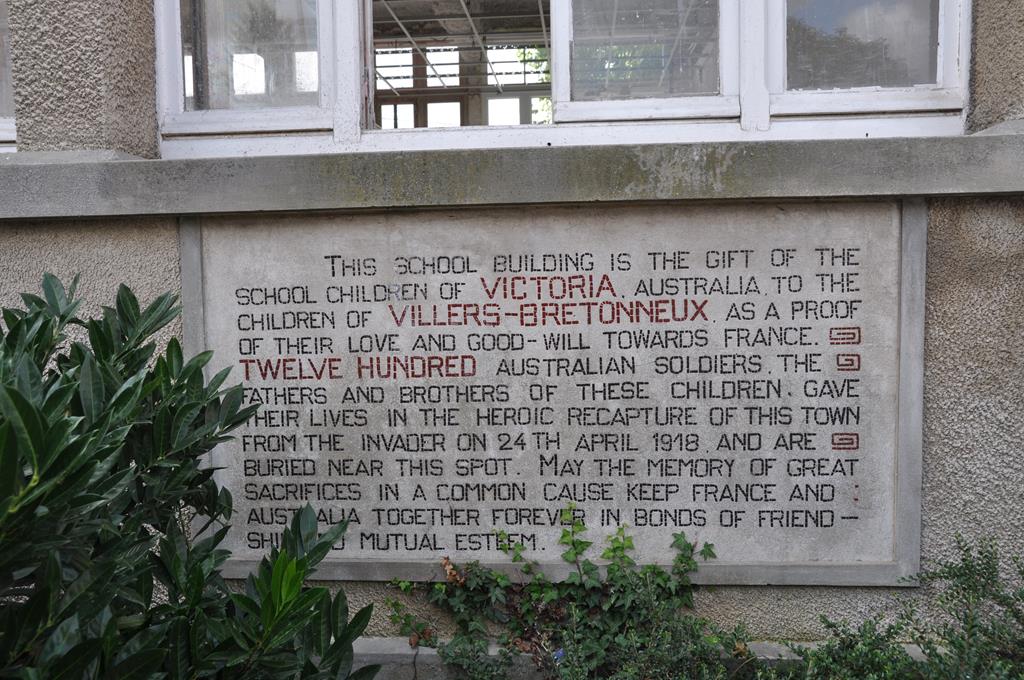
Villers-Bretonneux School
Australian soldiers and their families from Victoria decided soon after the war to build Villers-Bretonneux a school.
Victorian school-children were each urged to donate a penny and the Victorian Education Department donated 20,000 pounds ($40,000).
Above every blackboard is the inscription "N'oublions jamais l'Australie" (Let us never forget Australia).

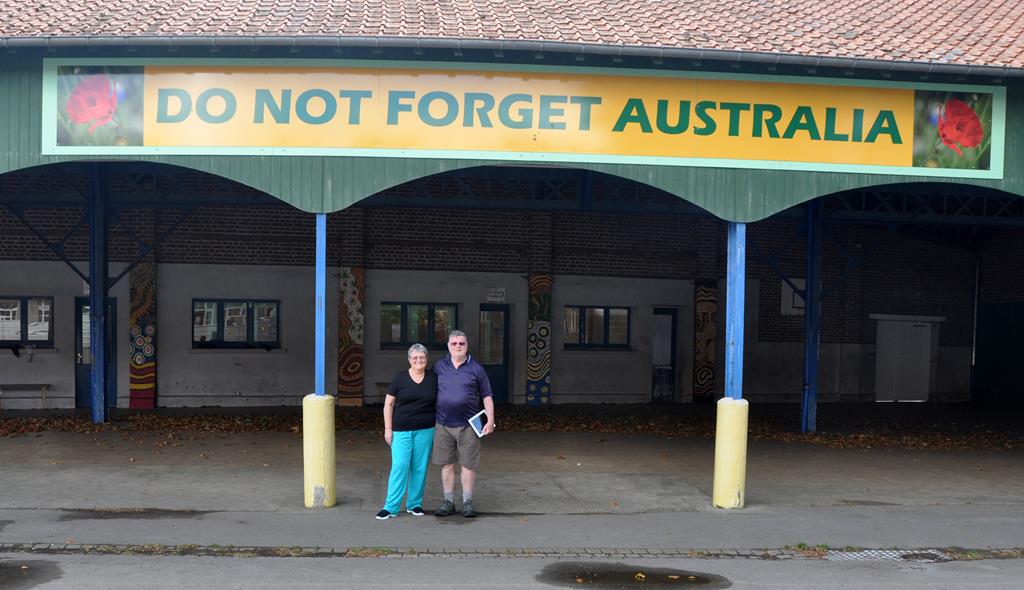
Australian National Memorial - Villers-Bretonneux
The Australian National Memorial, Villers–Bretonneux, is the main memorial to Australian military personnel
killed on the Western Front during World War I.
The memorial lists 10,773 names of soldiers of the Australian Imperial Force with no known grave who were killed
between 1916, when Australian forces arrived in France and Belgium, and the end of the war.
The location was chosen to commemorate the role played by Australian soldiers in the Second Battle of Villers-Bretonneux (24–27 April 1918).
It was unveiled in 1938.

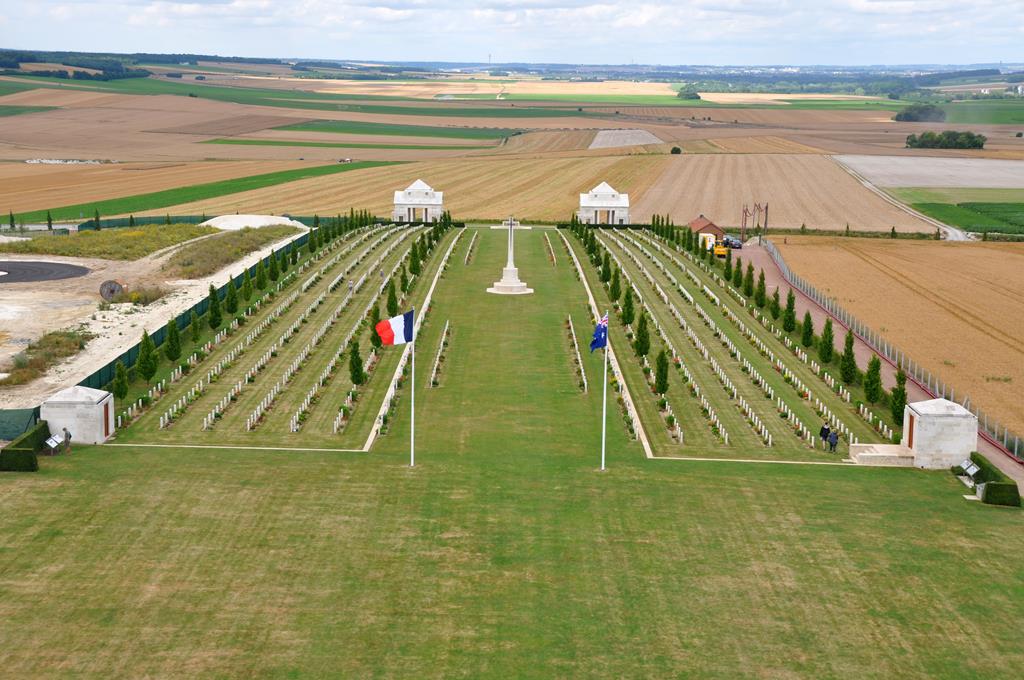
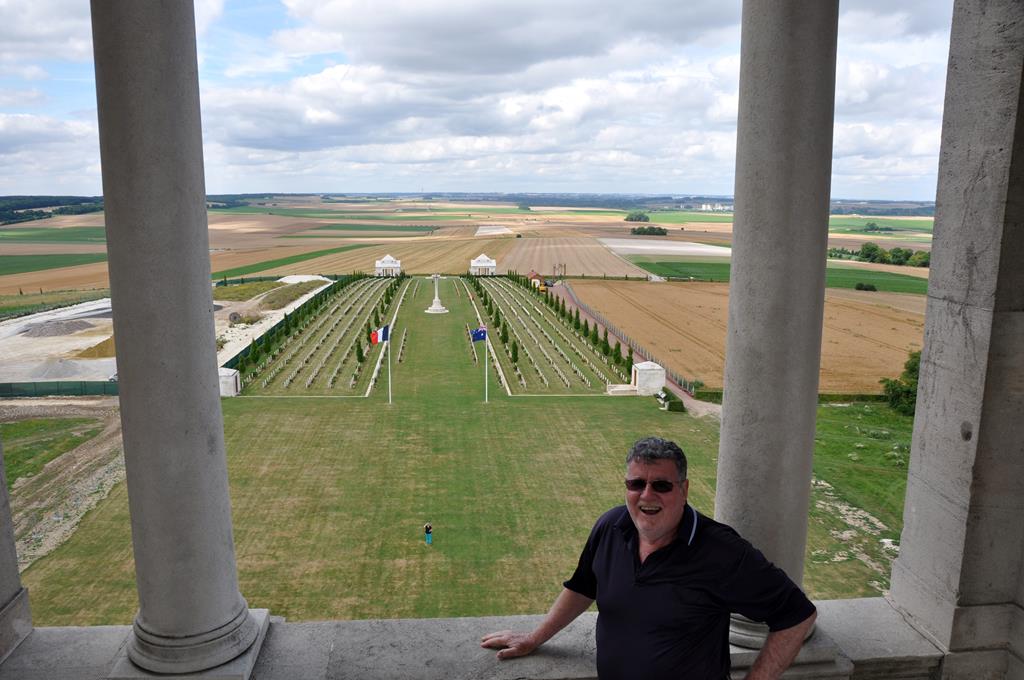
The Australian Corps Memorial Park - Le Hamel
The Australian Corps Memorial Park is situated on the brow of a hill east of Le Hamel village to the south of the River Somme.
The memorial park commemorates over 100,000 Australians who served with the Australian Corps in France during the First World War.
It was created as a memorial for the 80th anniversary of the Battle of Hamel, which marked the turn of the tide for the Allies
after the difficult period in the months of March and April 1918 following the German advances as far as Villers-Bretonneux.
The Battle of Hamel on 4 July 1918,lasted 85 minutes.
Starting at 3.10 am, then moving around Le Hamel village, the Western Australians advanced uphill,
and by 4.35 had driven the Germans from a series of trenches and dugouts on top of the hill.
The Australian Corps were led for the first time by Lieutenant General John (later Sir John) Monash.


Lavielle
Leonard Lyons, my great-uncle, was killed here on the 27th March 1918.
He was my paternal grandfather's brother.
He was a Sapper in the 4th Division Signal Engineers, 46th Battalion.
A Sapper, also called pioneer or combat engineer, is a combatant or soldier who performs a variety of military engineering duties
such as bridge-building, laying or clearing minefields, demolitions, field defences and general construction,
as well as road and airfield construction and repair.

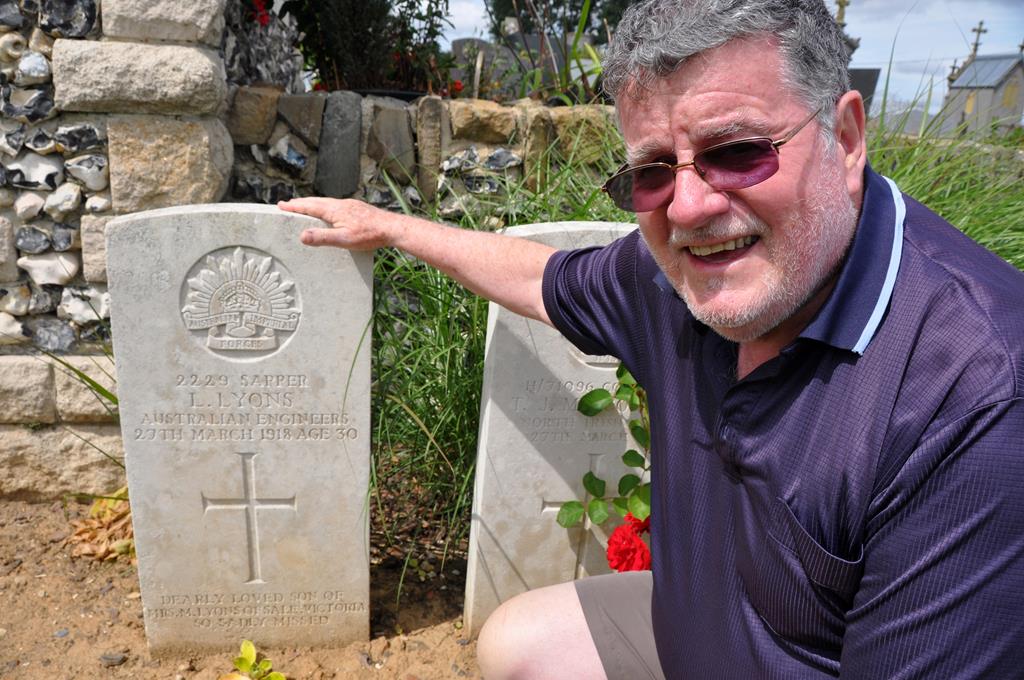
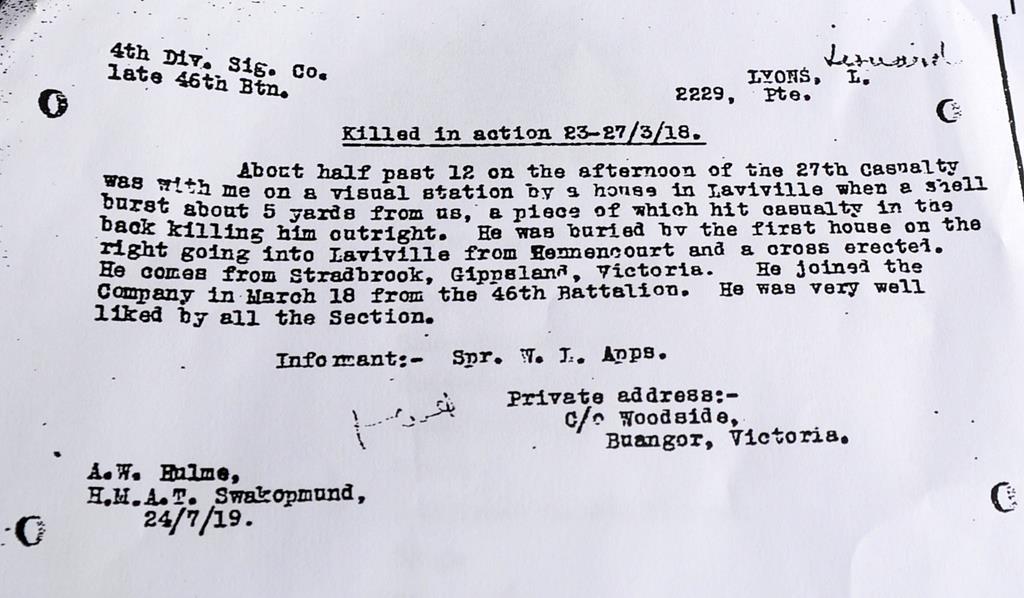
Beaumont-Hamel Newfoundland Memorial
The Beaumont-Hamel Newfoundland Memorial is dedicated to the commemoration of the Dominion of Newfoundland
forces members who were killed during World War I.
The preserved battlefield park encompasses the grounds over which the Newfoundland Regiment made their unsuccessful attack
on 1 July 1916 during the first day of the Battle of the Somme.
The Battle of the Somme was the regiment's first major engagement,
and during an assault that lasted approximately 30 minutes the regiment was all but wiped out.
Of the 780 men who went forward only about 110 survived unscathed, of whom only 68 were available for roll call the following day.
Like the Australians, the Newfoundlanders volunteered, trained in Egypt and fought at Gallipoli.
During the First World War, Newfoundland was a largely rural dominion of the British Empire with a population of 240,000, and not yet part of Canada.
(In 1949 Newfoundland became part of Canada - the province of Newfoundland and Labrador, the most easterly province of Canada.)
Some of the zig-zagged original trenches have been preserved here.
Trenches were never straight - that made it too easy for explosives to be fired right along them.

The Thiepval Memorial to the Missing of the Somme
The Thiepval Memorial to the Missing of the Somme is a war memorial to 72,246 missing British Empire servicemen
who died in the Battles of the Somme of the First World War between 1915 and 1918, with no known grave.
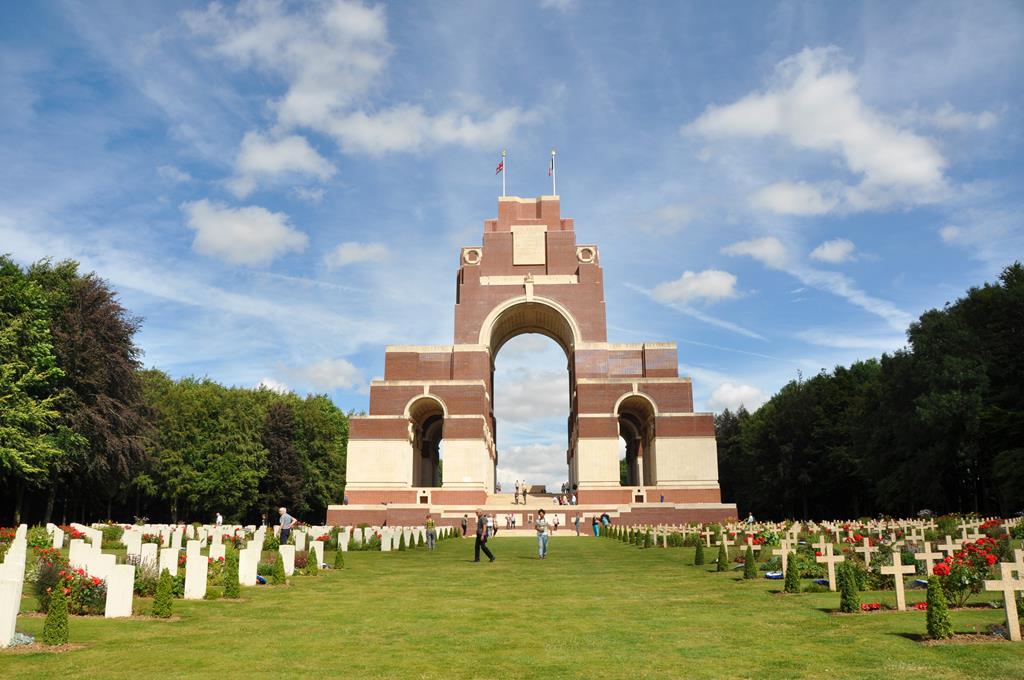
Lochnagar Crater
The Lochnagar mine was dug before the 1916 Battle of the Somme, of the First World War.
The mine was dug by the Tunnelling Companies of the Royal Engineers under a German field fortification known as Schwabenhöhe (Swabian Height),
in the front line, south of the village of La Boisselle in the Somme département of France.
The mine was named after Lochnagar Street, the British trench from which the gallery was driven.
The Lochnagar mine was sprung at 7:28 a.m. on 1 July 1916, the First day on the Somme.
The crater was captured and held by British troops but the attack on either flank was defeated by German small-arms and artillery fire.
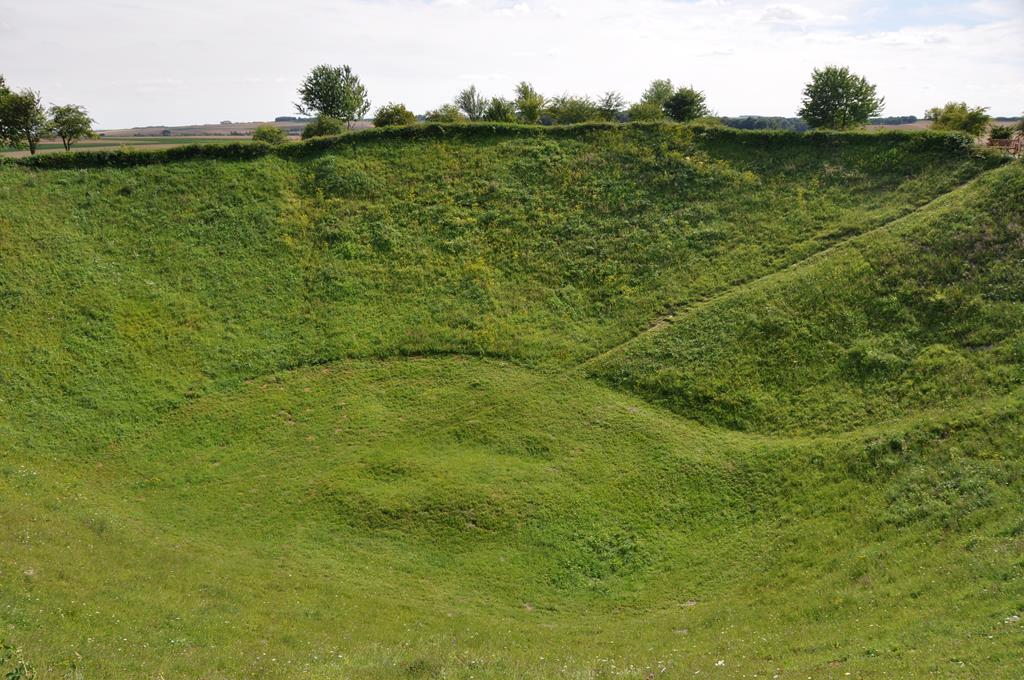
2nd Australian Division Memorial
This memorial is at Mont Saint-Quentin on the road from Bapaume to Péronne.
The base was erected in 1925.
It has bronze bas-reliefs by of men hauling and pushing a gun and of men advancing with bayoneted rifles and hand-grenades.
It had on its top an Australian soldier thrusting his bayonet through a German eagle.
However, in 1940, German soldiers smashed the memorial. A replacement statue of a thoughtful Australian soldier looking down was erected in 1971
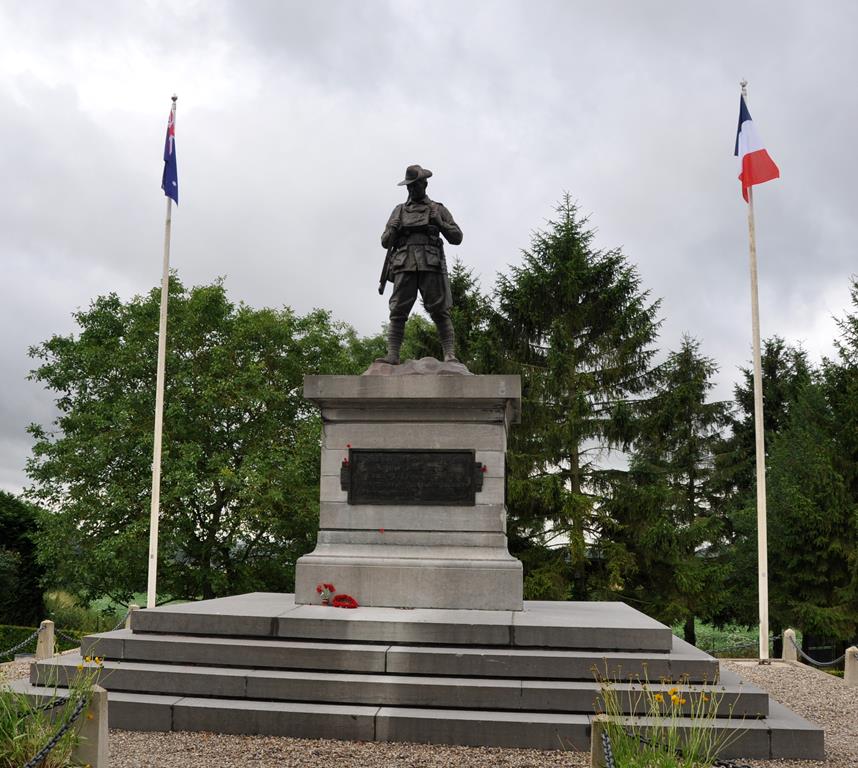
Edgar Towner VC Site
Edgar Thomas Towner, VC, MC (19 April 1890 – 18 August 1972) was an Australian recipient of the Victoria Cross,
the highest decoration for gallantry "in the face of the enemy" that can be awarded to members of the British and Commonwealth armed forces.
A lieutenant in the Australian Imperial Force during the First World War, Towner was awarded the Victoria Cross in 1918
for his actions during an attack on Mont St. Quentin on the Western Front.
Born in Queensland to a farming family, Towner led a machine gun section in attack near Morlancourt
and assisted the infantry in reaching its objectives under heavy fire, for which he was awarded the Military Cross.
In September, again commanding a machine gun section, he was involved in the Allied counteroffensive
that broke the German lines at Mont St. Quentin and Péronne.
Fighting for thirty hours after being wounded, his "conspicuous bravery, initiative and devotion to duty" earned him the Victoria Cross.
Discharged in August, Towner returned to Australia. He was appointed a director of the Russleigh Pastoral Company,
and briefly re-enlisted during the Second World War, when he was promoted to major.
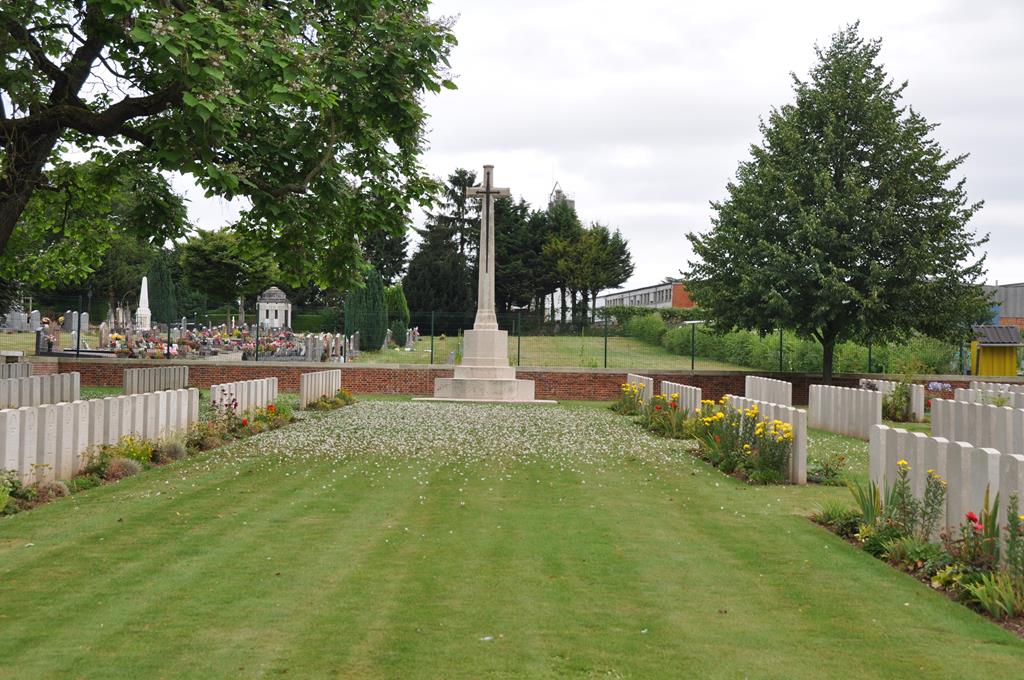
Historial de la Grande Guerre, Péronne
Péronne Museum of the Great War
Housed in the old mediaeval Péronne Castle, the museum has a good display about WWI.
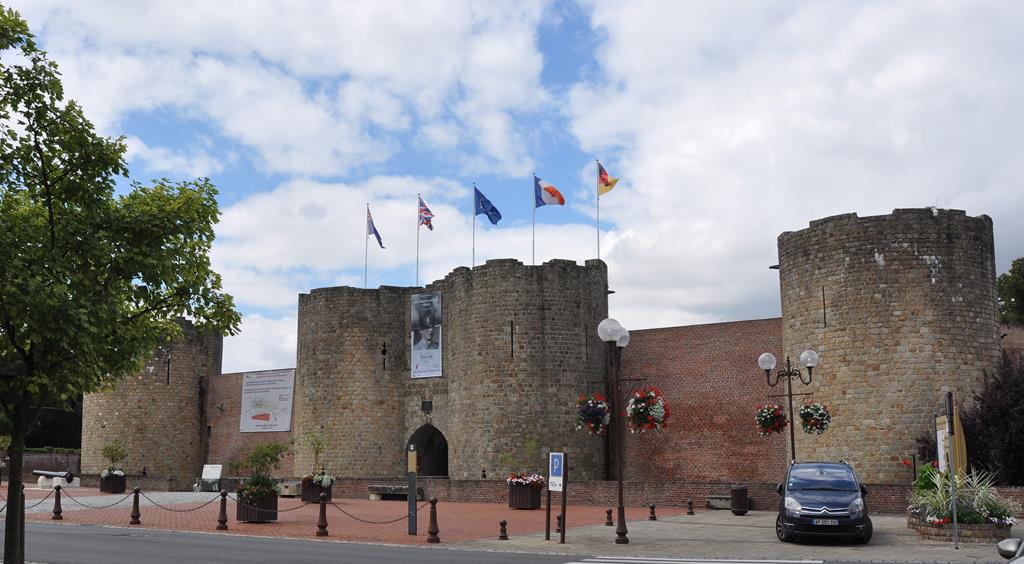
A French lunch in Péronne
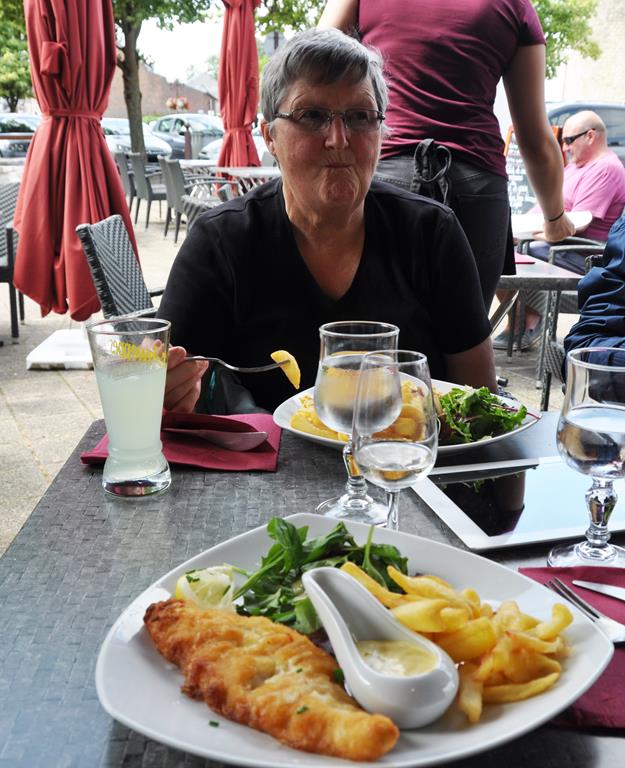

Maissemy German War Cemetery
The cemetery holds the remains of 30,478 German war dead of World War I.
More than 15,000 are buried in two massed graves.
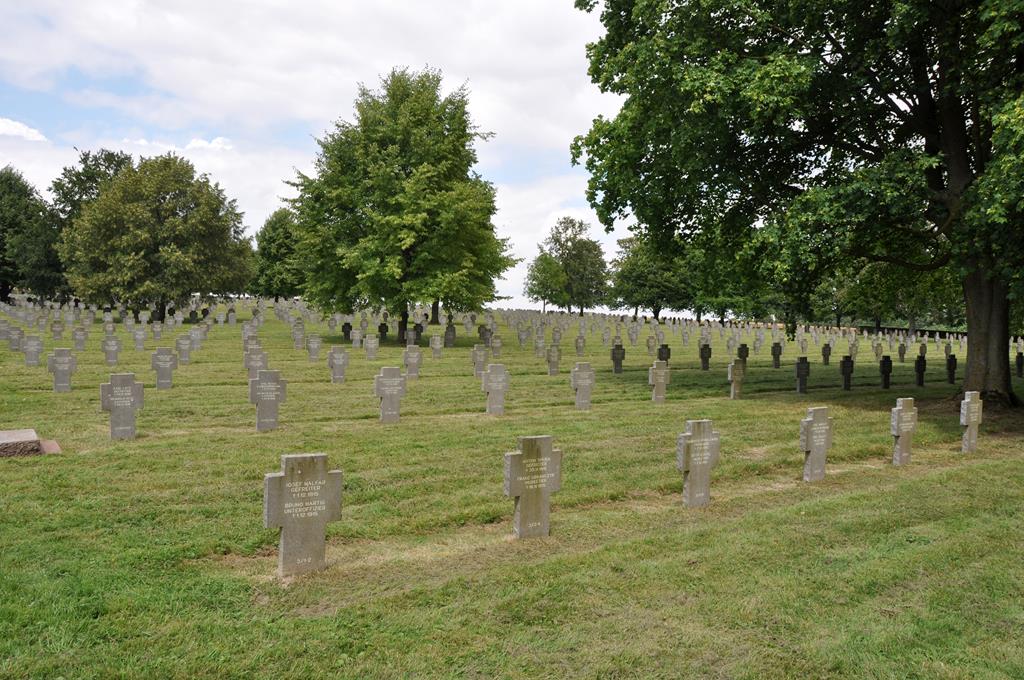
Australian 4th Division Memorial
This memorial over looks the St Quentin Canal at Bellenglise in France.
From this point in September 1918, the main German defences of The Hindenburg Line were visible and it was the scene
of an extremely successful operation and the culminating point of the Australian 4th Division's work in the war.
The Australian 4th Division was formed in Egypt in the First World War during the expansion of the Australian Imperial Force infantry brigades in February 1916.
It was formed from Gallipoli veterans and reinforcements from Australia.
The infantry, artillery, engineers and other support units of the division came to Europe in June 1916 and thereafter fought
in all major Australian actions in France and Belgium between 1916 and 1918.
During that time the division lost 10,973 dead and 27,000 wounded.
After the war ended and the AIF was demobilised, the division was dissolved.
In 1921, the 4th Division name was reactivated as a Citizen Military Forces formation.
The division performed home defence duties for most of World War II, before deactivation in 1944.
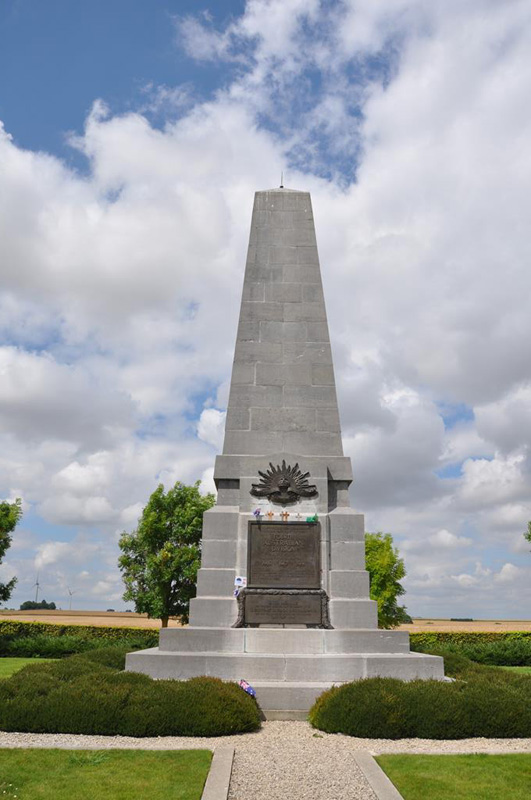
Riqueval Bridge
The Riqueval Bridge spans the St. Quentin Canal north of Bellinglise .
The Battle of St Quentin Canal was a pivotal battle of World War I that began on 29 September 1918 and involved British, Australian
and American forces in the spearhead attack and as a single combined force against the German Siegfried Stellung of the Hindenburg Line.
Under the command of Australian general Sir John Monash, the assault achieved all its objectives,
resulting in the first full breach of the Hindenburg Line, in the face of heavy German resistance and,
in concert with other attacks of the Great Offensive along the length of the line,
convinced the German high command that there was little hope of an ultimate German victory.

Brigadier General J V Campbell addressing troops from the Riqueval Bridge over the St Quentin Canal in 1918.

St. Quentin Canal Tunnel
The 92 km long Saint Quentin Canal links the Escaut River in Cambrai to the Canal latéral à l'Oise and Canal de l'Oise à l'Aisne in Chauny.
The canal was the main means of commercial water transportation between Belgium and Paris, with traffic so heavy as to require all locks to be doubled.
Canal work began in the late 1700s. Napoleon demanded that work be completed and he officiated at the opening in April 1810.
At Riqueval it was too difficult to make cuttings as the ground was very high. so they dug a 5.67 km long tunnel.
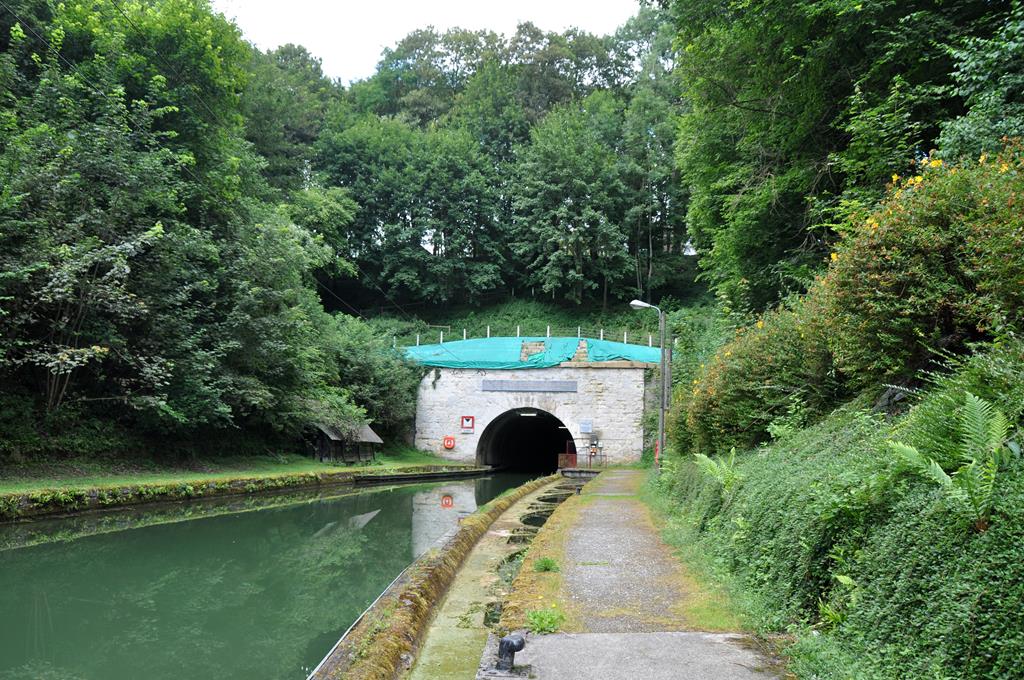
Somme American Memorial
The American Congress voted to declare war on Germany on April 6, 1917.
The first American troops landed in Europe in June 1917.
However they did not participate at the front until late October 1917.
The Bellicourt American Monument, built over St. Quentin Canal, commemorates the achievements and sacrifices of the 90,000 American troops
who served in battle with the British Armies in France during 1917 and 1918.
American troops came to the vicinity after fighting Belgium earlier in September 1918.
The St. Quentin Canal Tunnel passes beneath Bellicourt and Bony.
It was part of the Germans’ formidable Hindenburg Line, which was broken in September 1918.
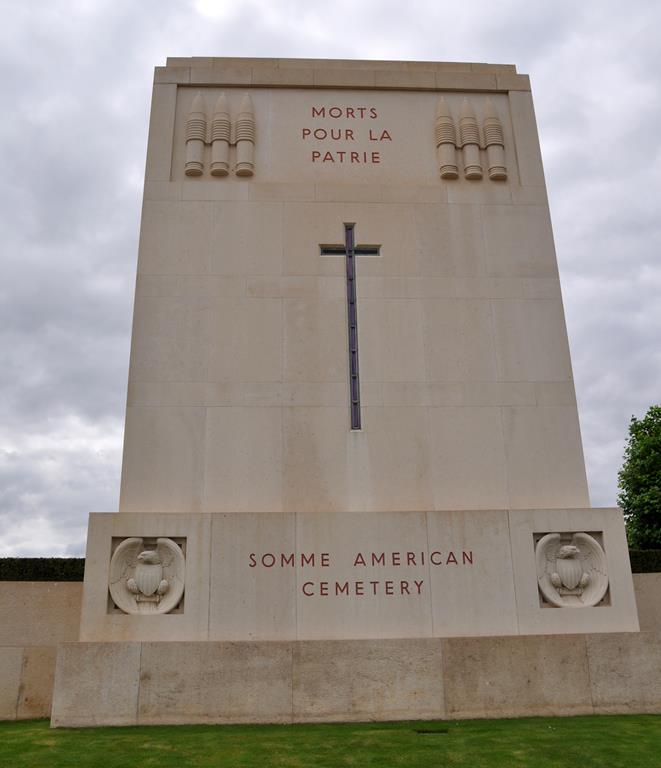
The cemetery contains the graves of 1,844 soldiers.
Most lost their lives while serving in American units attached to British armies, or in operations near Cantigny.
The American Congress voted to declare war on Germany on April 6, 1917.
The first American troops landed in Europe in June 1917.
However they did not participate at the front until late October 1917.

Noreuil Gully
Near Bullecourt, this is the battlefield where my great-uncle, Charles Richard McLaren was killed on the 22nd of April 1917.
He was putting night lights on the aiming posts when he got hit by a shell and was buried at about 1:15am.
There were two major battles at Bullecourt, on the 11th April 1917 and the 3rd May 1917, and he was killed between the two.
Charles Richard McLaren was a great-uncle of mine. He was my maternal grandmother's brother.
He was originally in the Light Horse Brigade but he transferred to the 15th Battery of the 5th Field Brigade.
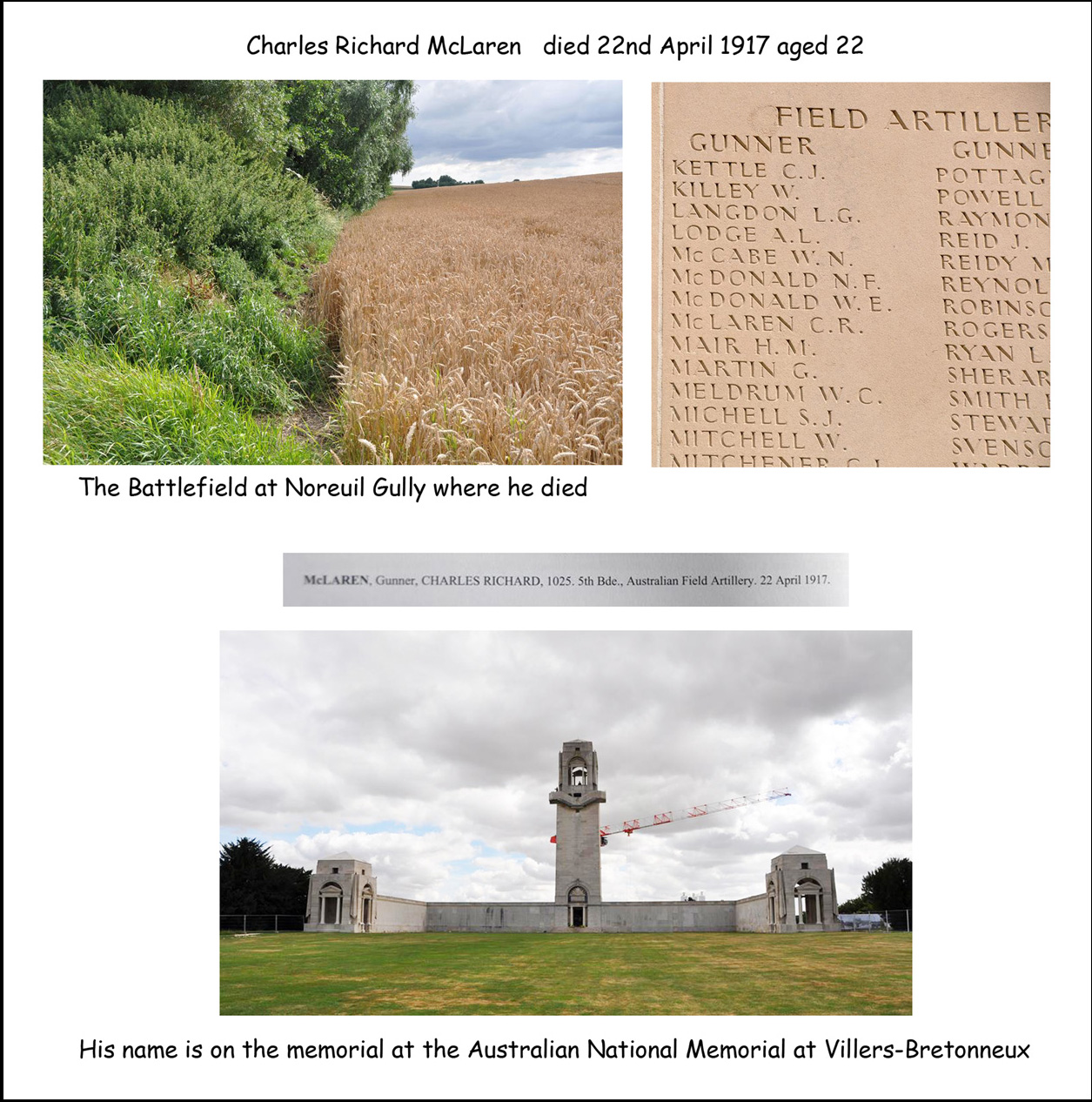
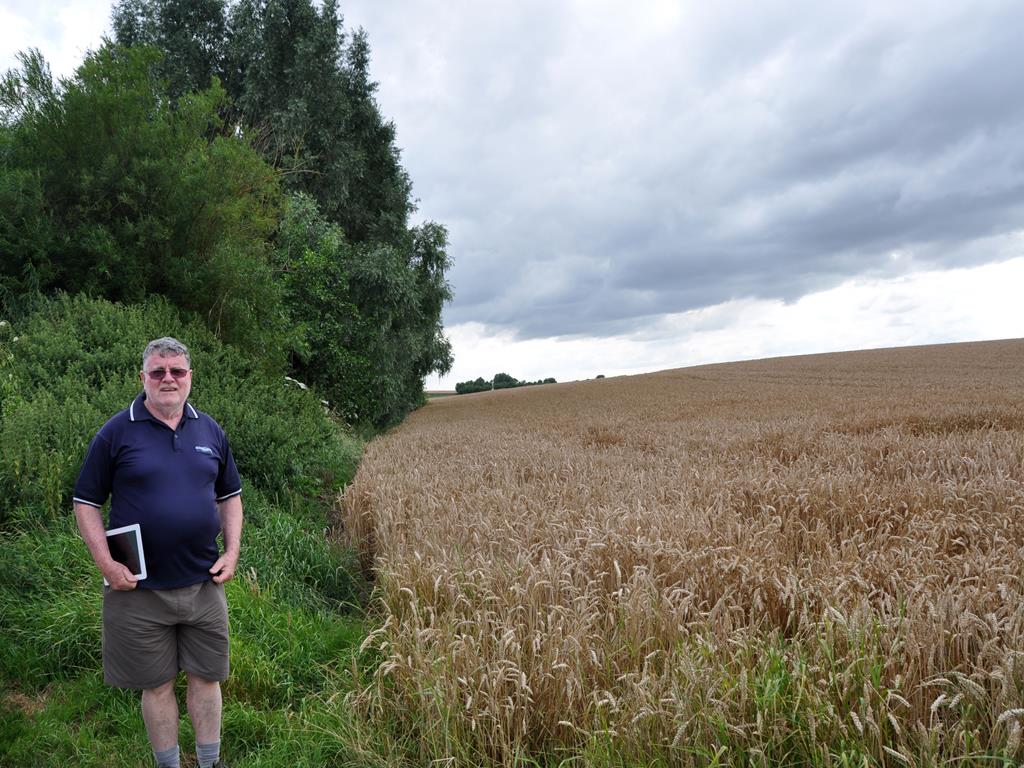
Petite Croix Memorial
Located in a small cutting on the road nead Bullecourt, this is a place of contemplation for the familes of the Commonwealth soldiers
who fell at Bullecourt.
It marks the location of the battles of 1917 and honours the memory of the 4,243 soldiers with no known resting place.

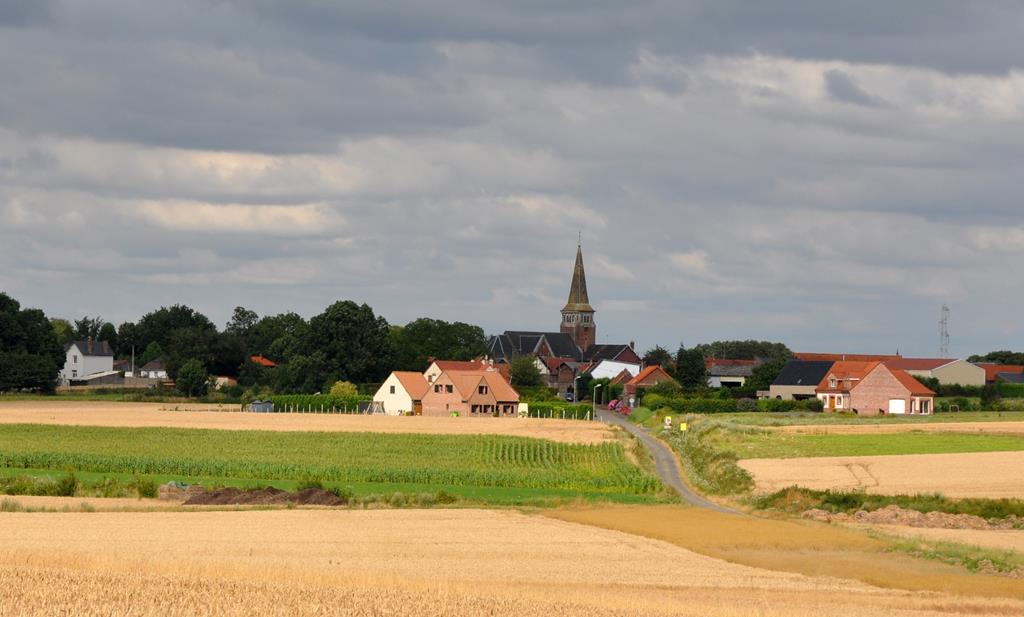
The Bullecourt Digger
Just outside Bullecourt, along the Rue des Australiens and along the side road to Reincourt–les–Cagnicourt,
is the Australian Memorial Park with its statue of the bronze ‘Bullecourt Digger’.
He gazes out over the fields of Bullecourt where in April and May 1917 the AIF lost 10,000 soldiers, killed or wounded,
in their efforts to break into and hold part of the Hindenburg Line.
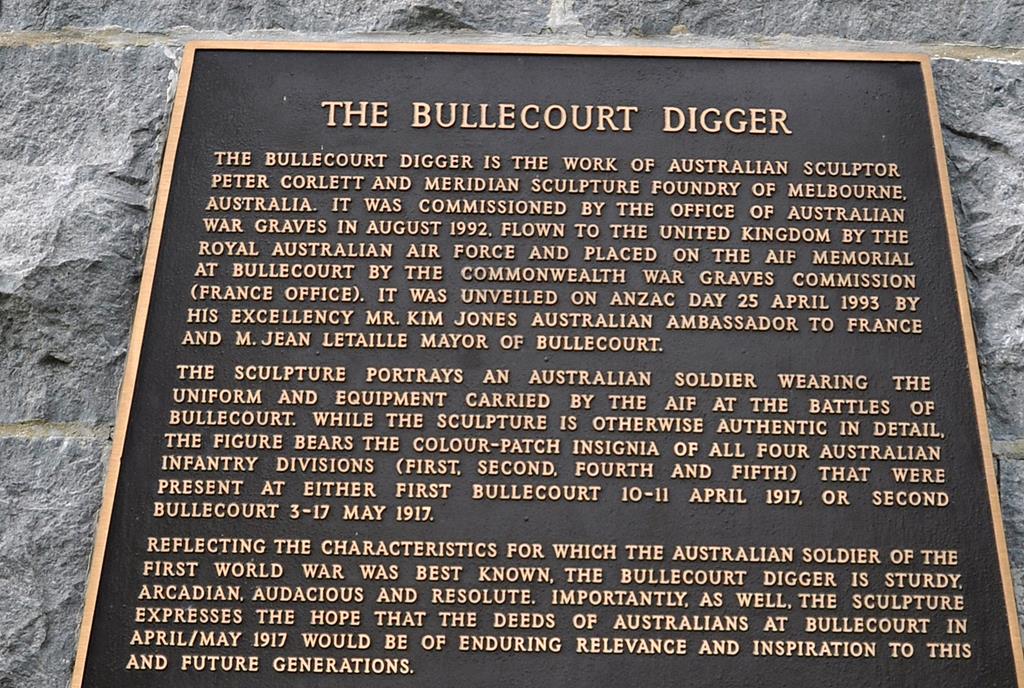

Maison Blanche German Cemetery
Located near Neuville-Saint-Vaast, a small village, near Arras, it is the largest German war cemetery in France, containing 44,833 burials.
Most died in intense fighting in Artois, on Lorette Spur (1914-15) and Vimy ridge (1917-18).
Up to 8 are buried under each cross and there are massed butial pits as well.

La Targette Cemetery
La Targette French Cemetery is located next to the British War Cemetery near the village of Neuvill-Saint-Vaast.
Most soldiers, who are buried here, were killed during the offensive which began on 9 May 1915.
The purpose of the Second Battle of Artois was to break the heavy lines of German defence before attacking Vimy Ridge.
At the time the Germans occupied Neuville-Saint-Vaast.
La Targette French Cemetery is understated, as all French War Cemeteries.
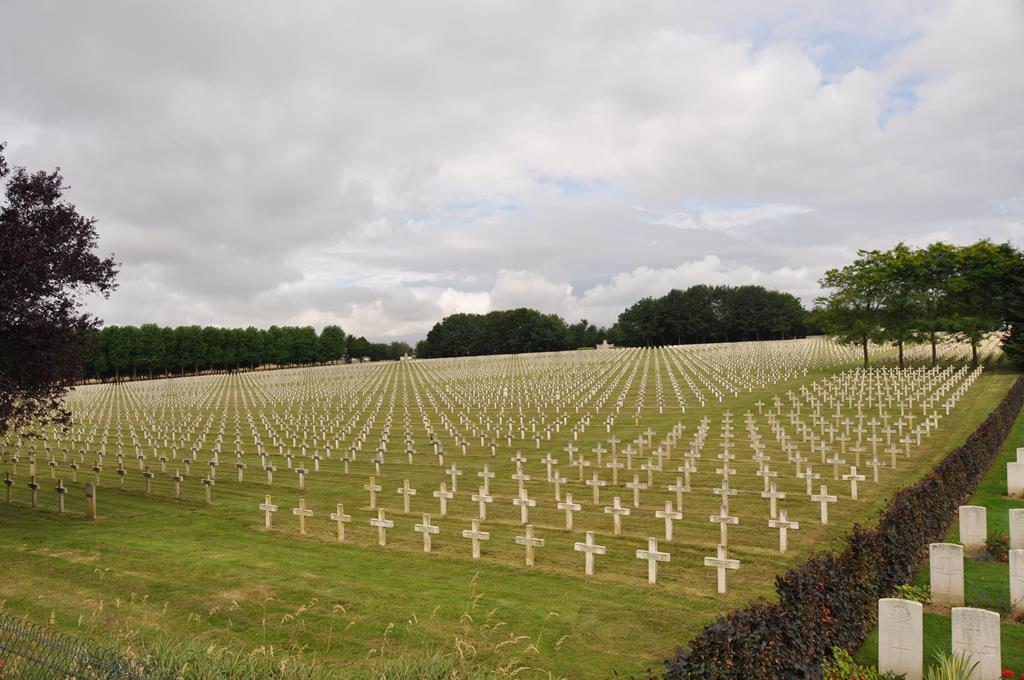
Vimy Ridge
The Battle of Vimy Ridge was a military engagement fought primarily as part of the Battle of Arras, during the First World War.
The main combatants were the Canadian Corps, of four divisions, against three divisions of the German Sixth Army.
The battle, which took place from 9 to 12 April 1917, was part of the opening phase of the British-led Battle of Arras,
a diversionary attack for the French Nivelle Offensive.
The objective of the Canadian Corps was to take control of the German-held high ground
along an escarpment at the northernmost end of the Arras Offensive.
This would ensure that the southern flank could advance without suffering German fire.
Supported by a creeping barrage, the Canadian Corps captured most of the ridge during the first day of the attack.
You can still see the bomb craters that are now overgrown with trees

They have preserved and renovated some of the trenches here
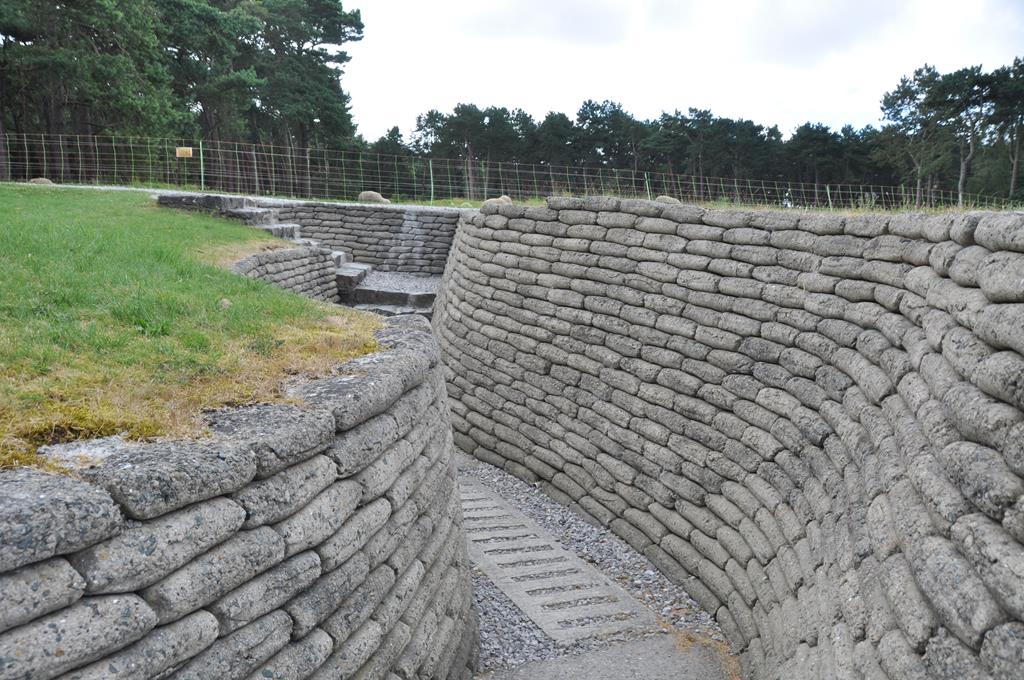
Pheasant Wood
These massed burial sites were discovered in 2008, just outside the village of Fromelles.
In 2009, the bodies of 250 Australian and British soldiers were systematically removed from the clay by osteoarchaeologists
(specialists in the study of human skeletal remains) and DNA samples were taken from teeth and bones.
The soldiers had been buried carefully by the Germans in distinct pits in two rows,
one above the other, at a depth of just over one metre and under two metres.

The Battle of Fromelles took place on the night of 19–20 July 1916, during the Somme Offensive of the Western Front in the First World War.
It was a diversionary battle, intended to draw the attention of the Germans away from the larger attacks elsewhere.
It involved units of the Australian 5th Division and the British 61st Division attacking German positions in and around Fromelles.
The German positions were well defended, and the battle led to huge losses by the attacking forces.
This was the first major battle on the Western Front involving the First Australian Imperial Force,
and has been described as "the worst 24 hours in Australia's entire history."
Records kept by the Commonwealth War Graves Commission show that 1,780 Australian soldiers and
503 British soldiers died in the battle, but many of these bodies were not recovered.
These missing dead are commemorated not by individual graves and names on headstones,
but by names carved on memorials dedicated for that purpose.
The Australian missing dead from the battle are inscribed on the memorial at the V.C. Corner Australian Cemetery and Memorial,
and over 400 unidentified bodies from the battle are also buried there.
Many of the dead were recovered by German forces after the battle and buried behind German lines.
Some of these burial sites were located in the years immediately following the First World War,
and the bodies were reburied in cemeteries in the area, including the V.C. Corner Cemetery.
The burial pits at Pheasant Wood remained undisturbed for over 90 years.
Their existence was discovered following research by retired Australian teacher Lambis Englezos.
Following a visit to Fromelles in 2002, Englezos calculated a discrepancy in the numbers of
unidentified Fromelles burials when compared to the lists of the missing.
Following up on this, he investigated the possibility that the missing bodies had been buried in unmarked mass graves by the Germans,
and never recovered since.
Several years of historical research, including examination of aerial photographs,
Red Cross records, and German war records, led to the discovery of these burial pits.
The bodies have been buried in a new cemetery - Pheasant Wood War Cemetery.
The Mayor of Fromelles suggested the new site so that "the dead could hear the bells of the cathedral".

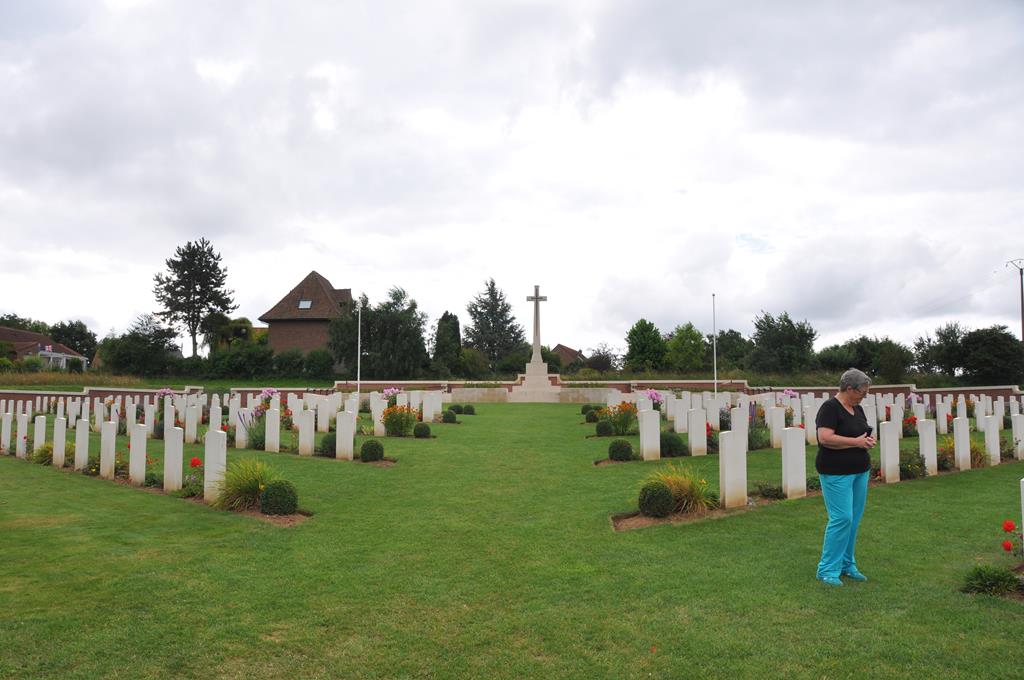
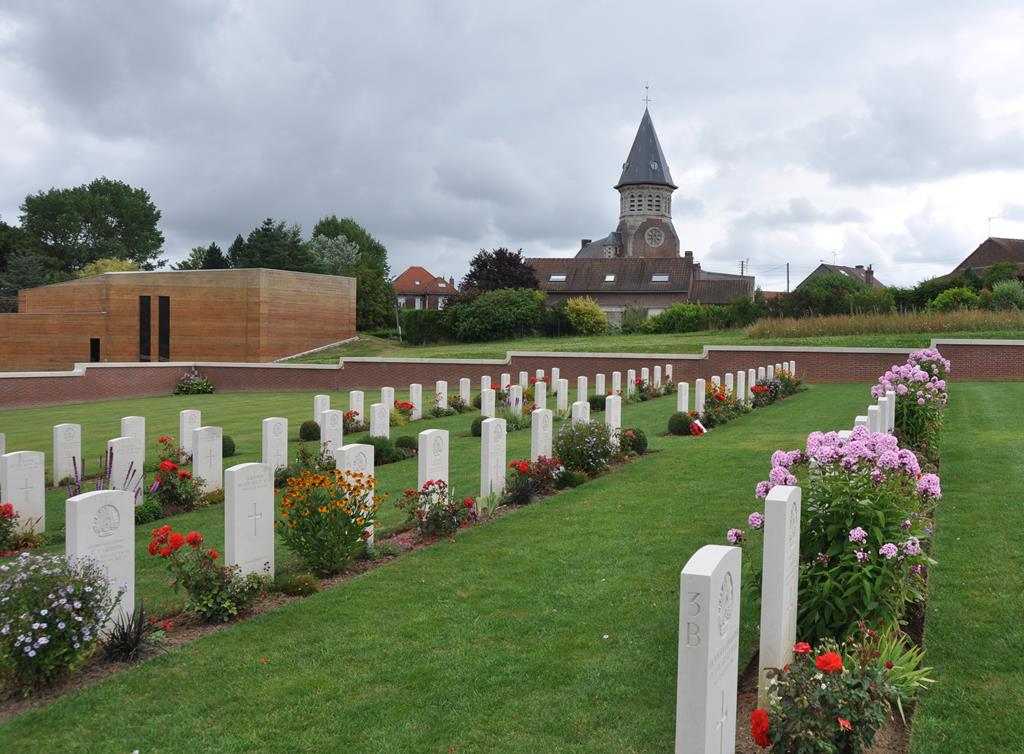
Cobbers Statue
This statue is located in the small Australian Memorial Park near Fromelles.
The park lies at the point where the German lines crossed the road leading to Fromelles.
Cobbers is a prominent 1998 sculpture by Peter Corlett of Sergeant Simon Fraser
rescuing a wounded compatriot from No Man's Land after the battle.
A replica of the sculpture is in the Shrine of Remembrance in Melbourne.
The title comes from a letter that Fraser, a farmer from Byaduk, Victoria, wrote a few days after the battle
and that was widely quoted in Australia's official history of World War I. ...
"We found a fine haul of wounded and brought them in; but it was not where I heard this fellow calling,
so I had another shot for it, and came across a splendid specimen of humanity trying to wriggle into a trench with a big wound in his thigh.
He was about 14 stone weight, and I could not lift him on my back; but I managed to get him into an old trench,
and told him to lie quiet while I got a stretcher.
Then another man about 30 yards out sang out 'Don’t forget me, cobber.'
I went in and got four volunteers with stretchers, and we got both men in safely."
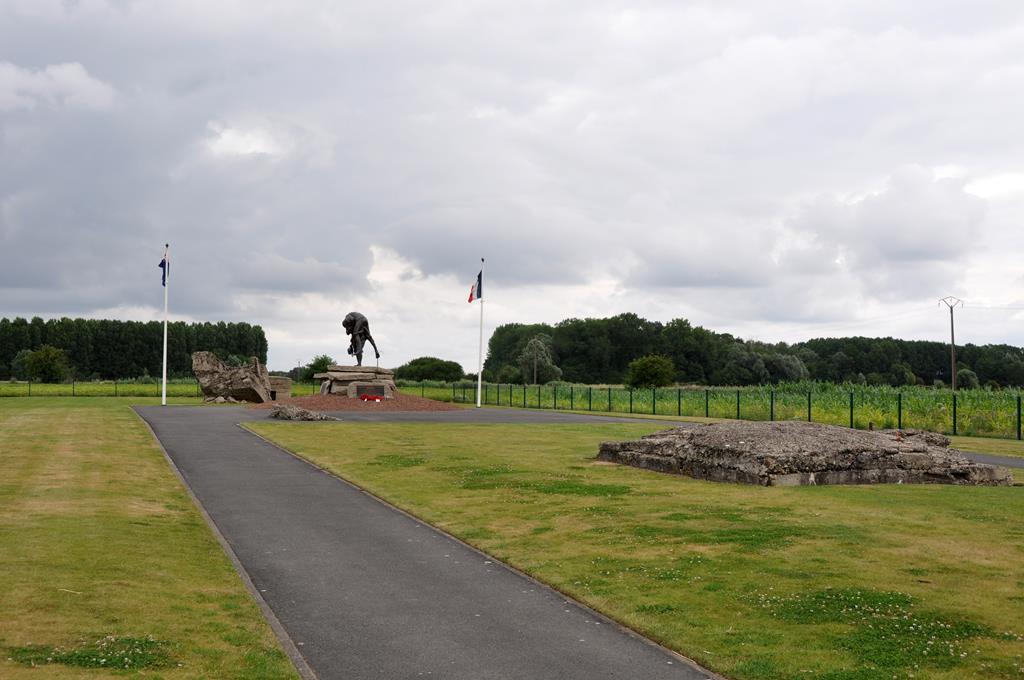
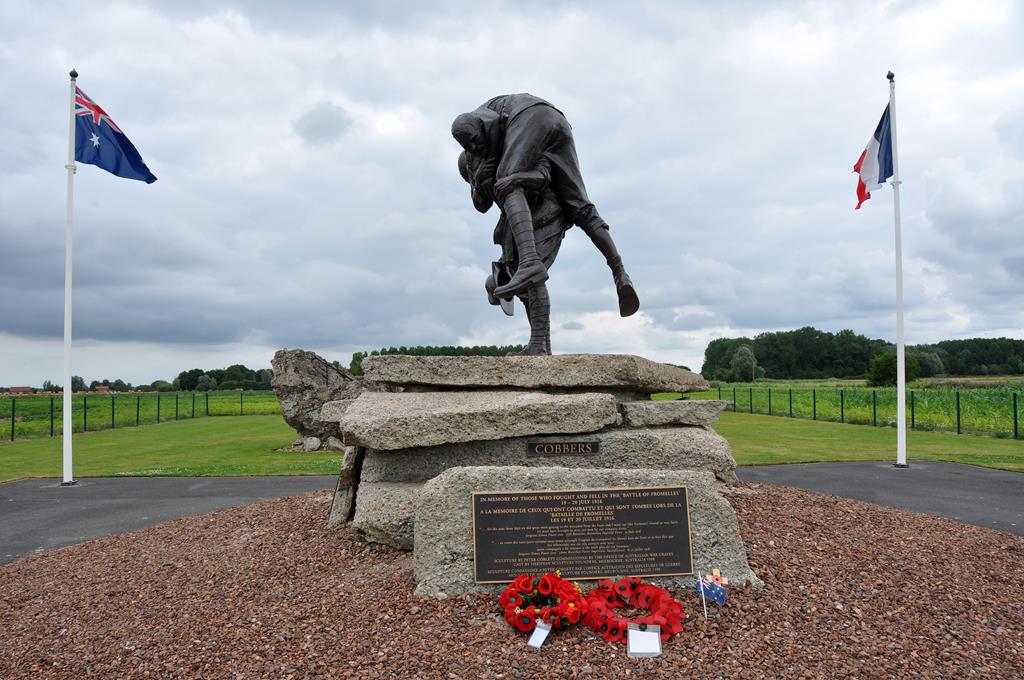

This sign is 100 metres up the road from Cobbers Statue on the way to nearby VC Corner.
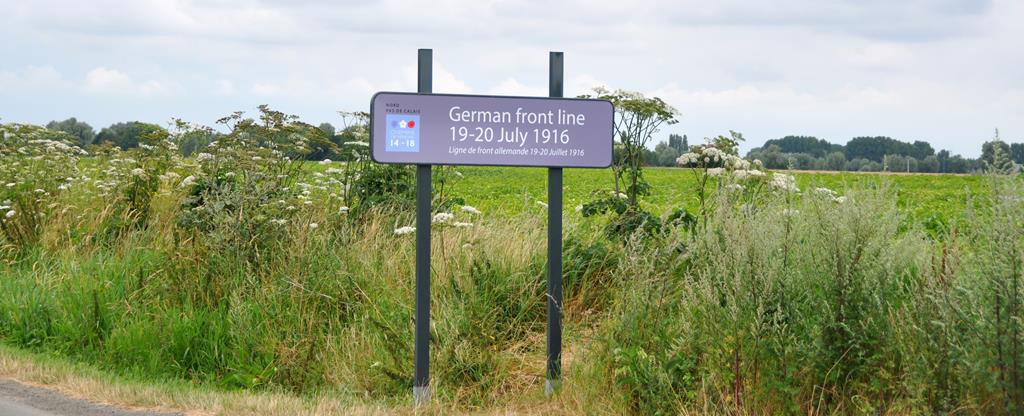
VC Corner
VC Corner cemetery is about 200 metres up the road from Cobbers Statue.
The cemetery contains 410 unidentified bodies who died in July 1916 in the Battle of Fromelles.
They were retrieved from the battlefield after the Armistice, that is, more than two years after the battle.
The memorial lists almost 1,300 Australian soldiers who were lost in the battle and who have no known resting place.
The Battle of Fromelles took place on the night of 19–20 July 1916, during the Somme Offensive of the Western Front in the First World War.
It was a diversionary battle, intended to draw the attention of the Germans away from the larger attacks elsewhere.
It involved units of the Australian 5th Division and the British 61st Division attacking German positions in and around Fromelles.
The German positions were well defended, and the battle led to huge losses by the attacking forces.
This was the first major battle on the Western Front involving the First Australian Imperial Force,
and has been described as "the worst 24 hours in Australia's entire history."
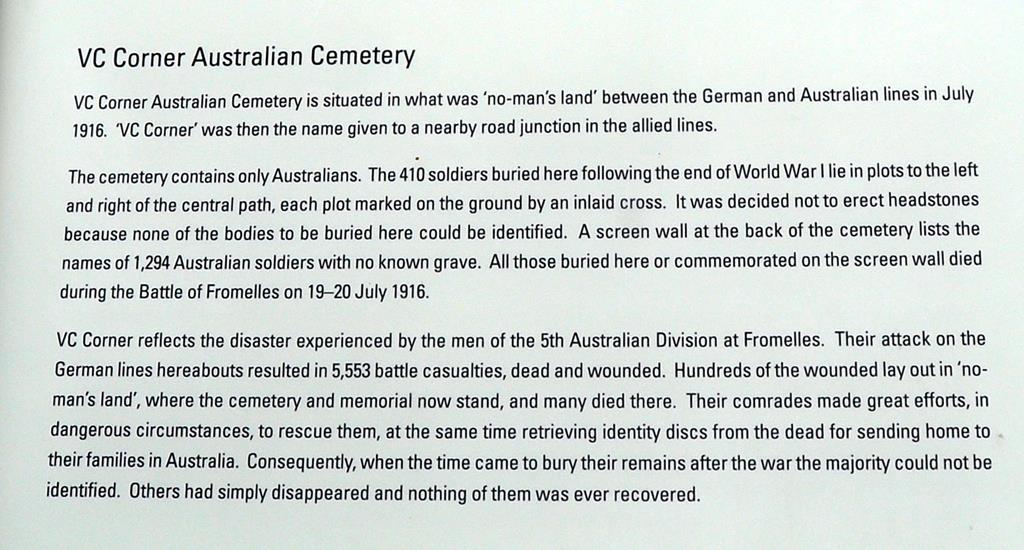
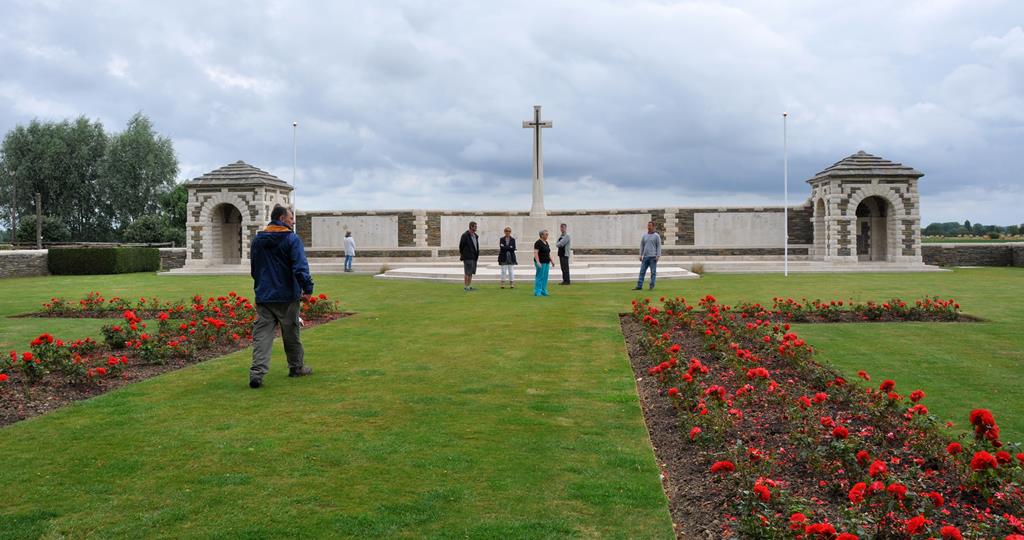
Sugar Loaf
Across the road from VC Corner was Sugar Loaf.
The Germans held the higher ground that overlooked the plain.
The key German positions were those of Sugar Loaf, a salient that jutted out from the German lines.
(Salient means "pointing outward".)
We walked on this area between the farmer's crops.
You could easily pick up shrapnel balls and bullet casings from the ground.
(When coming through Dubai airport on the way home, security officals detected our bullet casing souvenirs on X-rays. They allowed us to keep them.)
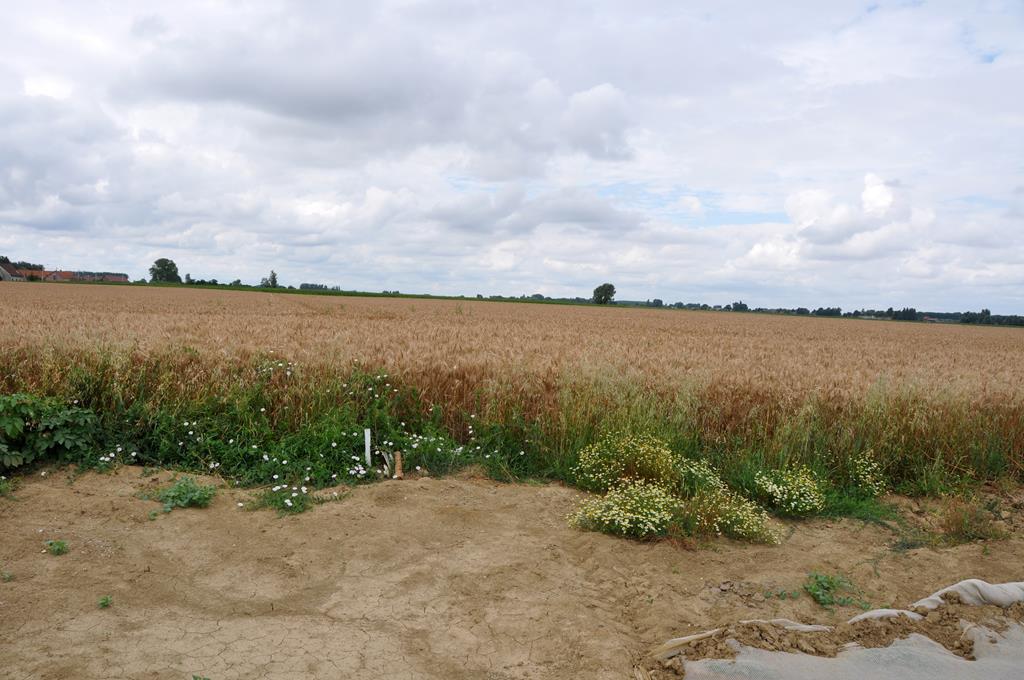
We crossed into Belgium and visited more WW1 battlefield sites.
After 4 nights in Arras we returned to Paris on the high-speed train.

After 4 days in Paris we flew to Lisbon in Portugal.
The Somme is a department of France, located in the north of the country and named after the Somme River.
The Battle of the Somme, also known as the Somme Offensive, was a battle of the First World War fought by the armies of the British Empire
and French Third Republic against the German Empire.
It took place between 1 July and 18 November 1916 on both sides of the upper reaches of the River Somme in France.
The battle was intended to hasten a victory for the Allies.
More than three million men fought in the battle and one million men were wounded or killed, making it one of the deadliest battles in human history.
We left Paris on a high-speed train to Arras in northern France.
The 180km, very smooth and comfortable trip, took 50 minutes.

Arras
Arras is a city of about 130,000 people in northern France about 180km from Paris.
Established during the Iron Age by the Gauls, it was once part of the Spanish Netherlands,
a portion of the Low Countries controlled by Spain from 1556 to 1714.
The city of Arras is well known for its architecture, culture and history.
We spent 4 nights in Arras, while we did daily tours to the World War 1 battlefields.

Our first stop, not far out of Arras, was at a place where farmers leave unexploded shells that they uncover in their fields.

The Windmill Site near Pozières
"The Windmill site ... marks a ridge more densely sown with Australian sacrifice than any other place on Earth".
Over seven weeks in 1916, at the Battle of the Somme, the Australian Imperial Force suffered 23,000 casualties,
more than 6700 of whom died, in the countryside around the Windmill.

Villers Bretonneux
In WWI, on 24 April 1918, the town of Villers-Bretonneux was the site of the world's first battle between two tank forces:
three British Mark IVs against three German A7Vs.
The Germans took the town, but that night and the next day it was recaptured by two brigades of the
First Australian Imperial Force at a cost of some 1200 Australian lives.
The town's mayor spoke of the Australian troops on 14 July 1919 when unveiling a memorial in their honour:
"The first inhabitants of Villers-Bretonneux to re-establish themselves in the ruins of what was once a flourishing little town have,
by means of donations,shown a desire to thank the valorous Australian Armies, who with the spontaneous enthusiasm
and characteristic dash of their race, in a few hours drove out an enemy ten times their number...
They offer a memorial tablet, a gift which is but the least expression of their gratitude,
compared with the brilliant feat which was accomplished by the sons of Australia...
Soldiers of Australia, whose brothers lie here in French soil, be assured that your memory will always be kept alive,
and that the burial places of your dead will always be respected and cared for.."

Villers-Bretonneux School
Australian soldiers and their families from Victoria decided soon after the war to build Villers-Bretonneux a school.
Victorian school-children were each urged to donate a penny and the Victorian Education Department donated 20,000 pounds ($40,000).
Above every blackboard is the inscription "N'oublions jamais l'Australie" (Let us never forget Australia).


Australian National Memorial - Villers-Bretonneux
The Australian National Memorial, Villers–Bretonneux, is the main memorial to Australian military personnel
killed on the Western Front during World War I.
The memorial lists 10,773 names of soldiers of the Australian Imperial Force with no known grave who were killed
between 1916, when Australian forces arrived in France and Belgium, and the end of the war.
The location was chosen to commemorate the role played by Australian soldiers in the Second Battle of Villers-Bretonneux (24–27 April 1918).
It was unveiled in 1938.



The Australian Corps Memorial Park - Le Hamel
The Australian Corps Memorial Park is situated on the brow of a hill east of Le Hamel village to the south of the River Somme.
The memorial park commemorates over 100,000 Australians who served with the Australian Corps in France during the First World War.
It was created as a memorial for the 80th anniversary of the Battle of Hamel, which marked the turn of the tide for the Allies
after the difficult period in the months of March and April 1918 following the German advances as far as Villers-Bretonneux.
The Battle of Hamel on 4 July 1918,lasted 85 minutes.
Starting at 3.10 am, then moving around Le Hamel village, the Western Australians advanced uphill,
and by 4.35 had driven the Germans from a series of trenches and dugouts on top of the hill.
The Australian Corps were led for the first time by Lieutenant General John (later Sir John) Monash.


Lavielle
Leonard Lyons, my great-uncle, was killed here on the 27th March 1918.
He was my paternal grandfather's brother.
He was a Sapper in the 4th Division Signal Engineers, 46th Battalion.
A Sapper, also called pioneer or combat engineer, is a combatant or soldier who performs a variety of military engineering duties
such as bridge-building, laying or clearing minefields, demolitions, field defences and general construction,
as well as road and airfield construction and repair.



Beaumont-Hamel Newfoundland Memorial
The Beaumont-Hamel Newfoundland Memorial is dedicated to the commemoration of the Dominion of Newfoundland
forces members who were killed during World War I.
The preserved battlefield park encompasses the grounds over which the Newfoundland Regiment made their unsuccessful attack
on 1 July 1916 during the first day of the Battle of the Somme.
The Battle of the Somme was the regiment's first major engagement,
and during an assault that lasted approximately 30 minutes the regiment was all but wiped out.
Of the 780 men who went forward only about 110 survived unscathed, of whom only 68 were available for roll call the following day.
Like the Australians, the Newfoundlanders volunteered, trained in Egypt and fought at Gallipoli.
During the First World War, Newfoundland was a largely rural dominion of the British Empire with a population of 240,000, and not yet part of Canada.
(In 1949 Newfoundland became part of Canada - the province of Newfoundland and Labrador, the most easterly province of Canada.)
Some of the zig-zagged original trenches have been preserved here.
Trenches were never straight - that made it too easy for explosives to be fired right along them.

The Thiepval Memorial to the Missing of the Somme
The Thiepval Memorial to the Missing of the Somme is a war memorial to 72,246 missing British Empire servicemen
who died in the Battles of the Somme of the First World War between 1915 and 1918, with no known grave.

Lochnagar Crater
The Lochnagar mine was dug before the 1916 Battle of the Somme, of the First World War.
The mine was dug by the Tunnelling Companies of the Royal Engineers under a German field fortification known as Schwabenhöhe (Swabian Height),
in the front line, south of the village of La Boisselle in the Somme département of France.
The mine was named after Lochnagar Street, the British trench from which the gallery was driven.
The Lochnagar mine was sprung at 7:28 a.m. on 1 July 1916, the First day on the Somme.
The crater was captured and held by British troops but the attack on either flank was defeated by German small-arms and artillery fire.

2nd Australian Division Memorial
This memorial is at Mont Saint-Quentin on the road from Bapaume to Péronne.
The base was erected in 1925.
It has bronze bas-reliefs by of men hauling and pushing a gun and of men advancing with bayoneted rifles and hand-grenades.
It had on its top an Australian soldier thrusting his bayonet through a German eagle.
However, in 1940, German soldiers smashed the memorial. A replacement statue of a thoughtful Australian soldier looking down was erected in 1971

Edgar Towner VC Site
Edgar Thomas Towner, VC, MC (19 April 1890 – 18 August 1972) was an Australian recipient of the Victoria Cross,
the highest decoration for gallantry "in the face of the enemy" that can be awarded to members of the British and Commonwealth armed forces.
A lieutenant in the Australian Imperial Force during the First World War, Towner was awarded the Victoria Cross in 1918
for his actions during an attack on Mont St. Quentin on the Western Front.
Born in Queensland to a farming family, Towner led a machine gun section in attack near Morlancourt
and assisted the infantry in reaching its objectives under heavy fire, for which he was awarded the Military Cross.
In September, again commanding a machine gun section, he was involved in the Allied counteroffensive
that broke the German lines at Mont St. Quentin and Péronne.
Fighting for thirty hours after being wounded, his "conspicuous bravery, initiative and devotion to duty" earned him the Victoria Cross.
Discharged in August, Towner returned to Australia. He was appointed a director of the Russleigh Pastoral Company,
and briefly re-enlisted during the Second World War, when he was promoted to major.

Historial de la Grande Guerre, Péronne
Péronne Museum of the Great War
Housed in the old mediaeval Péronne Castle, the museum has a good display about WWI.

A French lunch in Péronne


Maissemy German War Cemetery
The cemetery holds the remains of 30,478 German war dead of World War I.
More than 15,000 are buried in two massed graves.

Australian 4th Division Memorial
This memorial over looks the St Quentin Canal at Bellenglise in France.
From this point in September 1918, the main German defences of The Hindenburg Line were visible and it was the scene
of an extremely successful operation and the culminating point of the Australian 4th Division's work in the war.
The Australian 4th Division was formed in Egypt in the First World War during the expansion of the Australian Imperial Force infantry brigades in February 1916.
It was formed from Gallipoli veterans and reinforcements from Australia.
The infantry, artillery, engineers and other support units of the division came to Europe in June 1916 and thereafter fought
in all major Australian actions in France and Belgium between 1916 and 1918.
During that time the division lost 10,973 dead and 27,000 wounded.
After the war ended and the AIF was demobilised, the division was dissolved.
In 1921, the 4th Division name was reactivated as a Citizen Military Forces formation.
The division performed home defence duties for most of World War II, before deactivation in 1944.

Riqueval Bridge
The Riqueval Bridge spans the St. Quentin Canal north of Bellinglise .
The Battle of St Quentin Canal was a pivotal battle of World War I that began on 29 September 1918 and involved British, Australian
and American forces in the spearhead attack and as a single combined force against the German Siegfried Stellung of the Hindenburg Line.
Under the command of Australian general Sir John Monash, the assault achieved all its objectives,
resulting in the first full breach of the Hindenburg Line, in the face of heavy German resistance and,
in concert with other attacks of the Great Offensive along the length of the line,
convinced the German high command that there was little hope of an ultimate German victory.

Brigadier General J V Campbell addressing troops from the Riqueval Bridge over the St Quentin Canal in 1918.

St. Quentin Canal Tunnel
The 92 km long Saint Quentin Canal links the Escaut River in Cambrai to the Canal latéral à l'Oise and Canal de l'Oise à l'Aisne in Chauny.
The canal was the main means of commercial water transportation between Belgium and Paris, with traffic so heavy as to require all locks to be doubled.
Canal work began in the late 1700s. Napoleon demanded that work be completed and he officiated at the opening in April 1810.
At Riqueval it was too difficult to make cuttings as the ground was very high. so they dug a 5.67 km long tunnel.

Somme American Memorial
The American Congress voted to declare war on Germany on April 6, 1917.
The first American troops landed in Europe in June 1917.
However they did not participate at the front until late October 1917.
The Bellicourt American Monument, built over St. Quentin Canal, commemorates the achievements and sacrifices of the 90,000 American troops
who served in battle with the British Armies in France during 1917 and 1918.
American troops came to the vicinity after fighting Belgium earlier in September 1918.
The St. Quentin Canal Tunnel passes beneath Bellicourt and Bony.
It was part of the Germans’ formidable Hindenburg Line, which was broken in September 1918.

The cemetery contains the graves of 1,844 soldiers.
Most lost their lives while serving in American units attached to British armies, or in operations near Cantigny.
The American Congress voted to declare war on Germany on April 6, 1917.
The first American troops landed in Europe in June 1917.
However they did not participate at the front until late October 1917.

Noreuil Gully
Near Bullecourt, this is the battlefield where my great-uncle, Charles Richard McLaren was killed on the 22nd of April 1917.
He was putting night lights on the aiming posts when he got hit by a shell and was buried at about 1:15am.
There were two major battles at Bullecourt, on the 11th April 1917 and the 3rd May 1917, and he was killed between the two.
Charles Richard McLaren was a great-uncle of mine. He was my maternal grandmother's brother.
He was originally in the Light Horse Brigade but he transferred to the 15th Battery of the 5th Field Brigade.


Petite Croix Memorial
Located in a small cutting on the road nead Bullecourt, this is a place of contemplation for the familes of the Commonwealth soldiers
who fell at Bullecourt.
It marks the location of the battles of 1917 and honours the memory of the 4,243 soldiers with no known resting place.


The Bullecourt Digger
Just outside Bullecourt, along the Rue des Australiens and along the side road to Reincourt–les–Cagnicourt,
is the Australian Memorial Park with its statue of the bronze ‘Bullecourt Digger’.
He gazes out over the fields of Bullecourt where in April and May 1917 the AIF lost 10,000 soldiers, killed or wounded,
in their efforts to break into and hold part of the Hindenburg Line.


Maison Blanche German Cemetery
Located near Neuville-Saint-Vaast, a small village, near Arras, it is the largest German war cemetery in France, containing 44,833 burials.
Most died in intense fighting in Artois, on Lorette Spur (1914-15) and Vimy ridge (1917-18).
Up to 8 are buried under each cross and there are massed butial pits as well.

La Targette Cemetery
La Targette French Cemetery is located next to the British War Cemetery near the village of Neuvill-Saint-Vaast.
Most soldiers, who are buried here, were killed during the offensive which began on 9 May 1915.
The purpose of the Second Battle of Artois was to break the heavy lines of German defence before attacking Vimy Ridge.
At the time the Germans occupied Neuville-Saint-Vaast.
La Targette French Cemetery is understated, as all French War Cemeteries.

Vimy Ridge
The Battle of Vimy Ridge was a military engagement fought primarily as part of the Battle of Arras, during the First World War.
The main combatants were the Canadian Corps, of four divisions, against three divisions of the German Sixth Army.
The battle, which took place from 9 to 12 April 1917, was part of the opening phase of the British-led Battle of Arras,
a diversionary attack for the French Nivelle Offensive.
The objective of the Canadian Corps was to take control of the German-held high ground
along an escarpment at the northernmost end of the Arras Offensive.
This would ensure that the southern flank could advance without suffering German fire.
Supported by a creeping barrage, the Canadian Corps captured most of the ridge during the first day of the attack.
You can still see the bomb craters that are now overgrown with trees

They have preserved and renovated some of the trenches here

Pheasant Wood
These massed burial sites were discovered in 2008, just outside the village of Fromelles.
In 2009, the bodies of 250 Australian and British soldiers were systematically removed from the clay by osteoarchaeologists
(specialists in the study of human skeletal remains) and DNA samples were taken from teeth and bones.
The soldiers had been buried carefully by the Germans in distinct pits in two rows,
one above the other, at a depth of just over one metre and under two metres.

The Battle of Fromelles took place on the night of 19–20 July 1916, during the Somme Offensive of the Western Front in the First World War.
It was a diversionary battle, intended to draw the attention of the Germans away from the larger attacks elsewhere.
It involved units of the Australian 5th Division and the British 61st Division attacking German positions in and around Fromelles.
The German positions were well defended, and the battle led to huge losses by the attacking forces.
This was the first major battle on the Western Front involving the First Australian Imperial Force,
and has been described as "the worst 24 hours in Australia's entire history."
Records kept by the Commonwealth War Graves Commission show that 1,780 Australian soldiers and
503 British soldiers died in the battle, but many of these bodies were not recovered.
These missing dead are commemorated not by individual graves and names on headstones,
but by names carved on memorials dedicated for that purpose.
The Australian missing dead from the battle are inscribed on the memorial at the V.C. Corner Australian Cemetery and Memorial,
and over 400 unidentified bodies from the battle are also buried there.
Many of the dead were recovered by German forces after the battle and buried behind German lines.
Some of these burial sites were located in the years immediately following the First World War,
and the bodies were reburied in cemeteries in the area, including the V.C. Corner Cemetery.
The burial pits at Pheasant Wood remained undisturbed for over 90 years.
Their existence was discovered following research by retired Australian teacher Lambis Englezos.
Following a visit to Fromelles in 2002, Englezos calculated a discrepancy in the numbers of
unidentified Fromelles burials when compared to the lists of the missing.
Following up on this, he investigated the possibility that the missing bodies had been buried in unmarked mass graves by the Germans,
and never recovered since.
Several years of historical research, including examination of aerial photographs,
Red Cross records, and German war records, led to the discovery of these burial pits.
The bodies have been buried in a new cemetery - Pheasant Wood War Cemetery.
The Mayor of Fromelles suggested the new site so that "the dead could hear the bells of the cathedral".



Cobbers Statue
This statue is located in the small Australian Memorial Park near Fromelles.
The park lies at the point where the German lines crossed the road leading to Fromelles.
Cobbers is a prominent 1998 sculpture by Peter Corlett of Sergeant Simon Fraser
rescuing a wounded compatriot from No Man's Land after the battle.
A replica of the sculpture is in the Shrine of Remembrance in Melbourne.
The title comes from a letter that Fraser, a farmer from Byaduk, Victoria, wrote a few days after the battle
and that was widely quoted in Australia's official history of World War I. ...
"We found a fine haul of wounded and brought them in; but it was not where I heard this fellow calling,
so I had another shot for it, and came across a splendid specimen of humanity trying to wriggle into a trench with a big wound in his thigh.
He was about 14 stone weight, and I could not lift him on my back; but I managed to get him into an old trench,
and told him to lie quiet while I got a stretcher.
Then another man about 30 yards out sang out 'Don’t forget me, cobber.'
I went in and got four volunteers with stretchers, and we got both men in safely."



This sign is 100 metres up the road from Cobbers Statue on the way to nearby VC Corner.

VC Corner
VC Corner cemetery is about 200 metres up the road from Cobbers Statue.
The cemetery contains 410 unidentified bodies who died in July 1916 in the Battle of Fromelles.
They were retrieved from the battlefield after the Armistice, that is, more than two years after the battle.
The memorial lists almost 1,300 Australian soldiers who were lost in the battle and who have no known resting place.
The Battle of Fromelles took place on the night of 19–20 July 1916, during the Somme Offensive of the Western Front in the First World War.
It was a diversionary battle, intended to draw the attention of the Germans away from the larger attacks elsewhere.
It involved units of the Australian 5th Division and the British 61st Division attacking German positions in and around Fromelles.
The German positions were well defended, and the battle led to huge losses by the attacking forces.
This was the first major battle on the Western Front involving the First Australian Imperial Force,
and has been described as "the worst 24 hours in Australia's entire history."


Sugar Loaf
Across the road from VC Corner was Sugar Loaf.
The Germans held the higher ground that overlooked the plain.
The key German positions were those of Sugar Loaf, a salient that jutted out from the German lines.
(Salient means "pointing outward".)
We walked on this area between the farmer's crops.
You could easily pick up shrapnel balls and bullet casings from the ground.
(When coming through Dubai airport on the way home, security officals detected our bullet casing souvenirs on X-rays. They allowed us to keep them.)

We crossed into Belgium and visited more WW1 battlefield sites.
After 4 nights in Arras we returned to Paris on the high-speed train.

After 4 days in Paris we flew to Lisbon in Portugal.